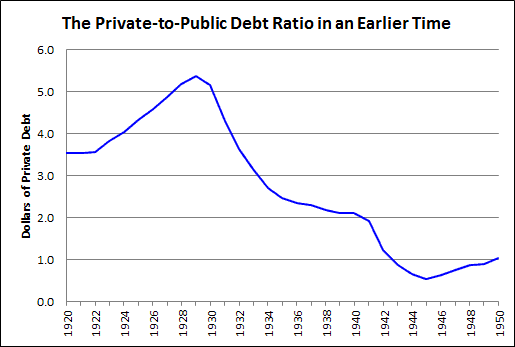From 1920 to 1928, private debt grew at an average rate of 5.4% per year. Public debt was not growing.
In 1929, the year the Depression started, private debt growth fell to 3.7 percent. The next year it went negative. From 1931 to 1933, private debt "grew" at the rate of -7.4% per year. It fell faster than it had grown in the Roaring '20s.
From 1934 to 1945, private debt grew at an average rate of zero point eight percent. Private debt was not growing.
 |
| Graph #1: Annual Growth Rates of Public (red) and Private (blue) Debt, 1920-1950 |
The growth of private and public debt shown on Graph #1 affected totals in both categories and moved the P2P ratio:
 |
| Graph #2: Private Debt relative to Public Debt, 1920-1950 |
The slowing of the downtrend extended the time it took to to bring the ratio low enough that the economy could resume growth.

It is foolish policy that allows the P2P ratio to reach such high levels. But only a fool would say that a Great Depression is the right solution to those high levels.
Nor is it the right solution to prevent the collapse of private debt, for this only pushes the good years farther off into the future.
The best solution is to prevent the ratio from climbing to such high levels. Prevent it before it happens. This means that policymakers must stop the growth of private debt before it creates a crisis.
You might think there are two ways to reduce the Private-to-Public debt ratio: Either reduce the growth of private debt or increase the growth of public debt. But increasing the growth of public debt turns out to be ineffective. Stuff happens: In the mid-30s the growth of public debt was reduced. In the 1970s and '80s the rapid growth of public debt induced rapid private debt growth, keeping the ratio at a high level for many years. And in recent years, policymakers have held that public debt growth must be restrained.
So there is really only one way to reduce the ratio of private-to-public debt, and that is to reduce private debt.

3 comments:
1. Decide on the desired level of public debt.
2. Reduce the level of private debt until the P2P ratio reaches the level most conducive to growth.
3. Reduce both private and public debt (keeping the P2P ratio stable) until the desired level of public debt is reached.
I guess we're still stuck at #1, huh.
I guess we could skip step 1 for now...
Post a Comment